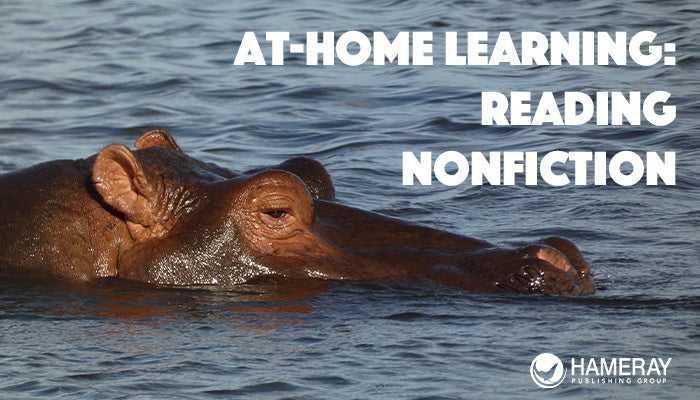Today's post is the first in our new series designed to support parents as they seek ways to augment their child’s at-home learning. This series will contain individual reading lessons, all of which have been adapted for parents, and each post will include online flipbooks, reading tips, and extensions ideas that can be done at home.
Today’s post is a typical guided reading lesson that a K–1 teacher might have with a small group of children. We've included all that you'll need to lead your children through this activity: the digital nonfiction book, Hippo, and lesson ideas below for working with your child before, during, and after reading.
This title is appropriate for children reading at guided reading level D (early first grade). You can see our leveling chart here.
*Please note that any scripts provided are not intended to be prescriptive. These are suggestions for parents.
Things to Do Before You Read The Book Together:
- Read the title out loud and display the cover.
- Follow up with your child, asking “How do we know this is a nonfiction book?”
- After they have answered, ask them for any predictions on the information they might learn.
- Ex: 'What new information will you learn about hippos?' 'What would you like to learn about hippos?'
Things to Do While You Read:
- When you come across an unknown word, encourage your child to use the images to figure out the word.
- You can help by asking questions like: 'What do you see in the picture?' 'Can you describe what’s happening in the picture?'
- Direct your child to read aloud with you when they recognize common sight words. Some common sight words are: look, with, all, the.
- If they stumble over a sentence, have them go back and reread the sentence or passage, so they can become comfortable with self-correcting.

You’re Finished Reading, What Now?
- Ask your child to compare and contrast what they expected to learn to with what they did learn from reading. Have them share the most interesting fact that they learned.
- Invite them to retell what they learned from the book! This is an easy way to check for comprehension.
- Review any new vocabulary.
Activities that Build Comprehension:
-
 Invite your child to write their own nonfiction story! Have them pick an animal to write a story about; before they begin writing, review the properties of nonfiction with kids (facts, true-life experiences, etc.).
Invite your child to write their own nonfiction story! Have them pick an animal to write a story about; before they begin writing, review the properties of nonfiction with kids (facts, true-life experiences, etc.).
- Have a show and tell session. Ask your child to retrieve their favorite item from around the house and give a fact-based presentation about it. During the session, ask them questions about the item, directing them to stick to the information they know to be true.




 Invite your child to write their own nonfiction story! Have them pick an animal to write a story about; before they begin writing, review the properties of nonfiction with kids (
Invite your child to write their own nonfiction story! Have them pick an animal to write a story about; before they begin writing, review the properties of nonfiction with kids (








































![6 Fun and Easy Activities to Practice Sequencing [Grades K-1]](http://www.hameraypublishing.com/cdn/shop/articles/Red_Typographic_Announcement_Twitter_Post-5_bf1ae163-a998-4503-aa03-555b038d1b76_600x.png?v=1689961568)
![Leveraging Prior Knowledge Before Writing and Reading Practice [Grades 1–2]](http://www.hameraypublishing.com/cdn/shop/articles/Red_Typographic_Announcement_Twitter_Post-4_600x.png?v=1689961965)




